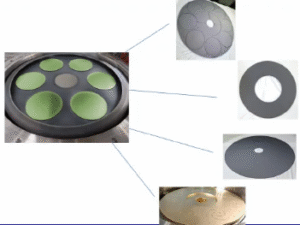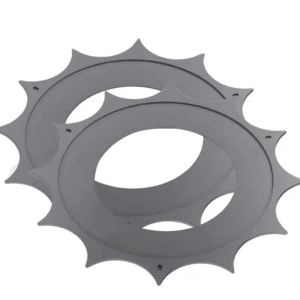
カーボンペーパーは燃料電池の重要な役割を担います、きれいなエネルギー解決のための礎石として役立つ。 効率的なガス拡散を確保し、触媒層をサポートし、反応中に生成された水を管理します。 燃料電池技術のカーボンペーパーの最近の進歩は性能に革命をもたらしました。 研究者は、その構造と材料特性を最適化し、エネルギー変換効率を高めています。 持続可能なエネルギーの需要が高まるにつれて、炭素紙の意義は上昇し続けています。 その革新的なアプリケーションは、現代の燃料電池システムに不可欠なコンポーネントを作る、クリーンエネルギーの未来を形作ります.
要点
- カーボンペーパーは燃料電池のために必要です、触媒層に有効なガス輸送を保障することによってエネルギー出力を最大限に活用するガス拡散の層として機能します.
- 最近の進展 カーボンペーパー技術 高められた気孔率および疎水性のような材料の特性を改良しましたり、よりよい熱および水管理に導きます.
- 低温ベーキングのような革新的な製造技術は、カーボン紙の生産をより持続可能で費用効果が大きい、全面的な燃料電池システムコストを削減しました.
- カーボンナノファイバーやグラフェンなどの先進材料の統合により、カーボンペーパーの耐久性と導電性を高め、燃料電池の性能を様々な条件下で改善します.
- カーボンペーパーの汎用性は、電気自動車から静止した電力システムまで、さまざまなアプリケーションをサポートし、エネルギーの浄化に貢献します.
- カーボンペーパー技術の研究開発は、燃料電池をより効率的、耐久性、そして広範な使用のためにアクセス可能にするさらなる革新を運転することを約束します.
燃料電池用カーボンペーパーの役割
カーボンペーパーは燃料電池の重要なコンポーネントとして機能し、効率的な運用を実現します。 そのユニークな特性は、燃料電池の性能と耐久性に直接影響を及ぼすいくつかの重要な機能に不可欠です。 詳しく見ていきましょう.
ガス拡散と輸送
燃料電池では、水素や酸素などの反応性ガスが触媒層に効率よく到達しなければなりません。 燃料電池用途用カーボン紙は、ガス拡散層(GDL)として機能することでこれを保証します。 気孔構造により、ガスを触媒面に均一に流すことができます。 この均一配分はよりよいエネルギー出力に導く電気化学反応を最大限に活用します。 適切なガス拡散がなければ、燃料電池の性能は大幅に低下します。 指示なしで目的地にガスを誘導する高速道路としてカーボンペーパーを考えることができます.
熱・水管理
燃料電池は操作の間に熱そして水を発生させます。 これらの副産物を管理することは、効率性を維持するために不可欠です。 燃料電池システム用カーボン紙は熱伝導性に優れ、熱を均等に散らすのに役立ちます。 過熱を防ぎ、安定した操作を保証します。 また、水管理における疎水性特性の補助も行っています。 膜を水和させるのに十分な湿気を保ちながら、余分な水の除去を容易にします。 余りに多くの水が細胞を損なうことができるので適切な水バランスは重要です、余りに少しは膜を乾燥できま、効率を減らします.
機械的サポートと耐久性
カーボンペーパーは燃料電池アセンブリに機械強さを提供します。 デリケートな触媒層をサポートし、取り扱いや運用時のダメージから保護します。 その堅牢な構造は、圧縮力に耐え、燃料電池は時間をかけてその完全性を維持します。 耐久性は、特に燃料電池が過酷な条件に直面しているアプリケーションで不可欠です。 強度とレジリエンスを両立させることで、燃料電池の長期信頼性に貢献します.
「カーボンシートへの炭素材料の統合は、特性を改善し、プロトン交換膜(PEM)燃料電池の効率を向上させるための大きな可能性を示しています。」 燃料電池技術の進歩におけるカーボン紙の重要性を強調しています.
これらの役割を果たすことで、カーボンペーパーは燃料電池の革新の礎石を残します。 ガス、熱、水、機械的ストレスを管理する能力は、燃料電池が最善で動作し、クリーナーエネルギーソリューションの方法を舗装することを保証します.
カーボンペーパー技術の最近の進歩
燃料電池用途向けのカーボンペーパーの進化が著しい改善をもたらしました。 これらの進歩は、材料特性を強化し、製造技術を磨き、他のコンポーネントとのシームレスな統合を保証します。 各ブレークスルーは、燃料電池をより効率的、耐久性、費用対効果の高いものにします.
物質的な特性の改善
研究者は、燃料電池システム用のカーボンペーパーの材料特性を最適化する重要な課題を挙げました。 近代的なカーボン紙は今高められた気孔率およびマイクロ構造を特色にします。 この改善により、ガスがより効果的に拡散し、燃料電池の全体的な性能を高めることができます。 カーボンナノファイバーやグラフェン系複合材などの先端材料も組み込まれています。 これらの材料は伝導性および耐久性を改善し、燃料電池がさまざまな条件の下で効率的に作動することを保障します.
もう一つの主要な開発はカーボンペーパーの疎水性の処置です。 この治療は、適切な水分補給レベルを維持しながら洪水を防ぐことで水管理を強化します。 長期使用中であっても、より安定した信頼性の高い燃料電池システムから利益を得ることができます。 これらの材料のアップグレードにより、カーボン紙はクリーンエネルギー技術の需要が高まっています.
製造技術の革新
カーボンペーパーの製造工程は重要な革新を経ています。 低温ベーキングと焼成法は、従来の生産技術に費用対効果の高い代替品として出現しました。 これらの方法は、製造中のエネルギー消費量を減らし、生産プロセスをより持続可能なものにします。 燃料電池システムの全体的なコストを下げるために、これらの進歩が期待できます.
さらに、精密エンジニアリング技術により、炭素紙の厚さと均一性をさらに向上できるようになりました。 燃料電池のあらゆる層に一貫した性能を発揮します。 カーボンナノファイバーをカーボン紙に直接増殖させることで、機能性を高めています。 この技術は、ガス拡散層の効率を改善し、高出力につながります.
他の燃料電池の部品との統合
他の燃料電池の部品が付いているカーボン ペーパーの継ぎ目が無い統合は優先順位になりました。 現代のデザインは、カーボン紙が触媒層と膜と調和して働く凝集システムを作成することに焦点を合わせています。 エネルギー損失を最小限に抑え、電気化学反応の効率を最大化します.
例えば、カーボンナノチューブコーティング繊維は、カーボン紙と触媒層のインターフェースを強化するために使用されます。 このイノベーションにより、反応性ガスや電子の伝達が向上し、エネルギー転換率が向上します。 高度燃料電池の設計との両立性を保障することによって、カーボン紙は未来にきれいなエネルギーの解決を運転するpivotal役割をし続けます.
「カーボンナノチューブコーティング繊維と組み合わせたときに、PEM燃料電池の最大電力密度を向上させるために、集中的な研究がカーボンペーパーの重要性を強調しました。」 これは、燃料電池技術の進歩における統合の重要な役割を果たしています.
燃料電池技術のカーボン紙のこれらの進歩は革新への継続的コミットメントを示す。 素材の改善、生産方法の改良、統合の強化により、研究者はより効率的で持続可能なエネルギーシステムへの道を切り拓きます.
アプリケーションおよび性能の強化
エネルギー転換の高められた効率
燃料電池システム用カーボン紙はエネルギー変換効率を大幅に向上させました。 その最適化された構造は、原子炉ガスが破壊することなく触媒層に到達することを保証します。 これは、電気化学反応を最大化し、より高い出力を達成することができます。 グラフェンベースの複合材、導電性を高め、運用時のエネルギー損失を最小限に抑えるなど、高度な材料。 これらの改善はよりよい性能に、燃料電池をきれいなエネルギー解決のための信頼できる選択にする翻訳します.
近代的なカーボンペーパーの熱・水管理性を高め、効率性を高めます。 理想的な運用環境を維持することで、洪水や脱水などの問題を防ぎます。 この安定性は、要求の厳しい条件下でも一貫したエネルギー生産を保証します。 これらの進歩により、燃料電池に依存して、優れたエネルギー転換率を実現します.
クリーンエネルギーの幅広い用途
燃料電池用途向けカーボンペーパーの汎用性は、さまざまなクリーンエネルギー分野にわたっての使用を拡大しました。 先進的なカーボンペーパーによって動力を与えられた燃料電池は、従来のエンジンに持続可能な代替手段を提供し、電気自動車を支えます。 また、遠隔地のための効率的なエネルギーソリューションを提供するポータブル電源システムでそれらを見つけることができます.
また、高機能カーボン紙を装備した静止燃料電池は、住宅や商業エネルギーのニーズに使用されます。 化石燃料の依存性を低減し、クリーンな電力と熱を提供します。 カーボンペーパー技術の適応性は多様な適用の関連性を保障し、より緑の未来に移行するのを助けます.
コストとスケーラビリティの改善
カーボン紙の生産の最近の革新は燃料電池をより費用効果が大きい作りました。 低温ベーキングのような技術は製造費を削減し、燃料電池システムをあなたのためにより手頃な価格にする。 これらの進歩はまた、品質を妥協することなく大量生産を可能にスケーラビリティを向上させます.
カーボンナノファイバーなどの耐久性のある材料の統合は、炭素紙の寿命を延ばします。 交換コストを削減し、長期保存を実現します。 生産方法が進化し続けるにつれて、燃料電池がよりアクセス可能になり、クリーンエネルギー市場での採用を加速することができます.
「燃料電池のカーボン紙市場は、2024年から2031年までの9.1%の化合物年間成長率(CAGR)で大幅に成長する予定です。」 この成長は、クリーンエネルギー技術における費用対効果の高いスケーラブルなソリューションの需要の増加を強調しています.
効率を高め、アプリケーションを拡張し、手頃な価格を改善することにより、燃料電池システム用のカーボンペーパーはクリーンエネルギーの進歩を推進しています。 これらの進歩により、持続可能なエネルギーソリューションを自信をもって満たすことができます.
燃料電池システム用カーボンペーパーは、クリーンエネルギー技術の進歩に不可欠であることを証明しました。 効率性、耐久性、スケーラビリティを向上させる役割は、現代の燃料電池の重要性を強調しています。 素材の特性や加工技術の進歩は、イノベーションの新しい可能性を秘めています。 これらの開発は、現在のアプリケーションを強化するだけでなく、将来のブレークスルーのための方法を保存します。 研究が続くにつれて、より持続可能なエネルギーソリューション、よりクリーンなエネルギーソリューションを駆動するために、カーボンペーパー技術が期待できます。 燃料電池の未来は、この変化の最前線でカーボン紙で有望に見えます.
よくあるご質問
燃料電池のカーボンペーパーは何ですか?
カーボンペーパーは燃料電池のガスの拡散の層(GDL)として機能します。 水素や酸素などの反応性ガスの輸送を触媒層に容易にします。 その多孔質構造は有効なガスの流れを保障します、一方の疎水性の特性は電気化学反応の間に作り出される水を管理するのを助けます.
なぜ燃料電池の性能のために重要なカーボン紙か?
カーボンペーパーは燃料電池が効率的に作動することを保障する重要な役割を担います。 ガス拡散をサポートし、熱と水を管理し、機械的強度を提供します。 これらの機能は燃料電池のエネルギー転換の効率、耐久性および信頼性に直接影響を与えます.
カーボンペーパーの進歩が燃料電池を改善する方法か?
最近の進歩により、炭素紙の材料特性や製造技術を強化しました。 研究者は、その気孔率、微小構造、および疎水性を最適化しました。 これらの改良により、ガス拡散、熱管理、耐久性が向上し、燃料電池の性能が向上します.
現代のカーボン紙で使われている材料は何ですか?
カーボンナノファイバーやグラフェンベースの複合材などの先進材料を取り入れた現代カーボン紙。 導電性、耐久性、水質管理を改善します。 燃料電池の全体的な効率をさまざまな作動条件下で高めます.
カーボンペーパーは、クリーンエネルギーソリューションにどのように貢献しますか?
燃料電池は、燃料電池が最小限の環境影響で電力を生成することを可能にします。 エネルギー転換の効率を改善し、より広い適用を支えることによって、化石燃料の信頼性を減らすのに役立ちます。 これは、持続可能なエネルギーシステムへの移行に重要なコンポーネントになります.
燃料電池以外の用途ではカーボンペーパーを使用できますか?
はい、カーボンペーパーに燃料電池を越えて適用があります。 電池、スーパーキャパシタ、その他のエネルギー貯蔵システムに使用されています。 独自の特性で、さまざまなクリーンエネルギー技術に適し、再生可能エネルギー市場での役割を拡大します.
最近のカーボンペーパー革新の費用メリットは何ですか?
低温ベーキングやシチューナノファイバーの成長などのイノベーションは、生産コストを削減しました。 これらの進歩により、燃料電池をより手頃な価格でスケーラブルにすることができます。 コストを削減することで、さまざまな産業における燃料電池技術の採用がより広く促進されます.
炭素紙は燃料電池で水を管理する方法は?
カーボンペーパーの疎水性の特性は膜を水和させるために十分な湿気を保っている間余分な水を取除くのを助けます。 このバランスは、洪水や脱水を防ぎ、安定した効率的な燃料電池操作を保証します.
カーボンペーパー技術の未来は何ですか?
カーボンペーパー技術の未来は有望です。 本研究では、材料特性の改善、コストの削減、および他の燃料電池コンポーネントとの統合強化に重点を置いています。 燃料電池の効率性、耐久性、アクセス性の向上を目指します.
カーボンペーパーは燃料電池のスケーラビリティにどのように影響しますか?
カーボンペーパー製造方法の進歩は拡張性を改善しました。 精密工学および費用効果が大きい製作のような技術は質を妥協しないで大量生産を可能にします。 このスケーラビリティは、クリーンエネルギー市場で燃料電池の需要が高まっています.






